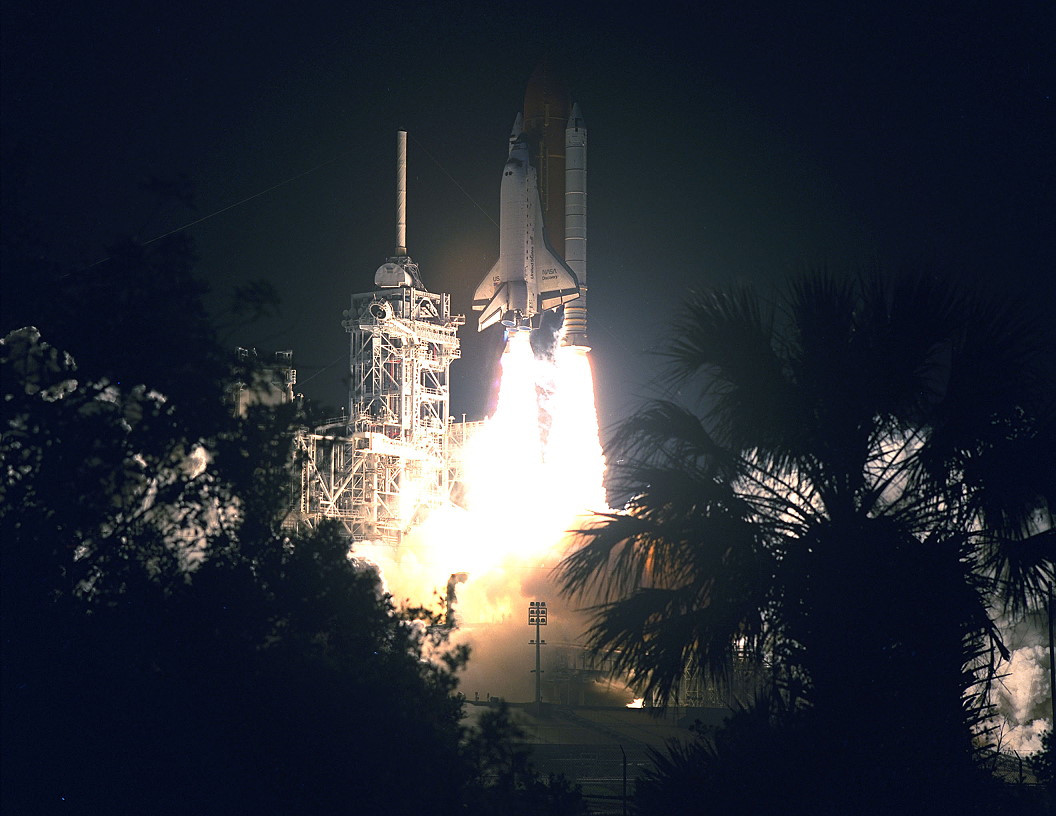
Twenty-five years ago, tonight, in the seconds leading up to 1:29 a.m. EDT on 8 April 1993, all eyes were on the three dark bells of Discovery’s Space Shuttle Main Engines (SSMEs), as they were readied for ignition. It would be the 16th mission by an orbiter which went on to become the most-flown member of NASA’s shuttle fleet, but STS-56 came after several fraught days at the Kennedy Space Center (KSC) in Florida. Two weeks earlier, shuttle Columbia had endured a harrowing, on-the-pad shutdown of her engines, just a few seconds before liftoff, and Discovery’s own mission had been similarly hit by the gremlins of misfortune. Yet astronauts Ken Cameron, Steve Oswald, Mike Foale, Ken Cockrell and Ellen Ochoa would turn night into day across the marshy environs of the Space Coast and complete a spectacular mission of scientific discovery, focused on the Home Planet.
Video Credit: NASA
In the aftermath of Columbia’s Redundant Set Launch Sequencer (RSLS) abort on 22 March, her STS-55 mission was stood down for a month, in order that corrective action could be taken and her engines removed and replaced. A few days later, NASA formally declared that Discovery’s STS-56 mission would take pole position and fly first in the early April timeframe, with an initial target launch date of the 6th. Primary payload was the second Atmospheric Laboratory for Applications and Science (ATLAS-2)—laden with an array of instruments to monitor Earth’s atmosphere and climate and its interaction with the Sun—and timing was critical if the mission was to observe seasonal changes between spring and summer in the northern hemisphere.
The countdown on the evening of the 6th proceeded smoothly until the built-in hold at T-9 minutes, when an issue cropped up pertaining to higher-than-expected temperatures on a valve in Discovery’s No. 1 engine. The clock was held for more than an hour, before controllers finally resumed counting at 1:23 a.m. EDT on the 7th. At T-31 seconds, the “Go” for autosequence start was initiated and primary control of all vehicle functions transitioned over to the shuttle’s on-board computers. The safe-and-arm devices on the Solid Rocket Boosters (SRB)s were armed and Cameron and his crew braced themselves for the immense jolt of Main Engine Start at T-6.6 seconds.
It never came.
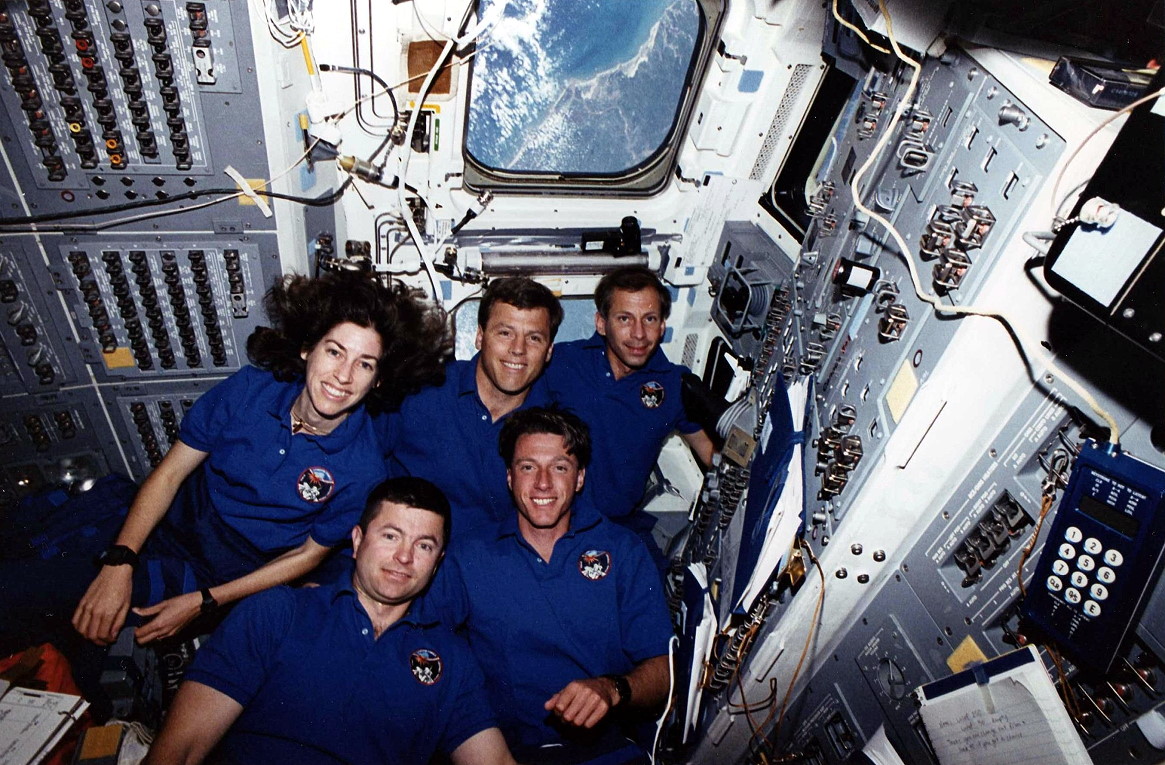
At T-11 seconds, abruptly, the clock was automatically halted and STS-56’s date with space was scrubbed. It later became clear that the hydrogen high-point bleed valve’s “closed” indicator was not present and, although this turned out to be an instrumental error and not an actual hardware issue, it created a breach of Launch Commit Criteria (LCC). The disappointed astronauts departed Discovery, unaware of when their next launch attempt might be. Fortunately, engineering checks of the valve turned up no problems and NASA felt able to reschedule another attempt for the small hours of 8 April.
This time, nothing conspired against STS-56 and the crew were strapped into their seats aboard the shuttle, with Cameron, Oswald, Ochoa and Cockrell on the flight deck and Foale downstairs in the darkened middeck. Lifting off at 1:29 a.m. EDT, Discovery created an artificial sunrise across KSC, as the mission marked only the eighth nocturnal launch of the shuttle program. With Cockrell and Ochoa both on their first flights, and all of the veterans having previously launched in the daytime hours, it presented a wholly different dynamic. “We cleared the tower right on time, right at the very opening of the window,” Oswald recalled later, “and these things are spectacular enough in the daytime. The three of us who had flown before had a daytime launch…and they’re even better at night!”
During the Roll Program maneuver, ten seconds after liftoff—as the shuttle stack oriented itself onto the proper alignment for its 8.5-minute ascent to orbit—the upstairs crew could easily see the reflection of the SRB exhaust plumes off the clouds. “The ascent first stage is always a little bit of a rough ride, going uphill,” continued Oswald, “but the boosters and the main engines performed absolutely flawlessly.” He remembered the experience of SRB separation from his previous mission, likening it to a train wreck, but the difference in brightness when flying at night was profound.
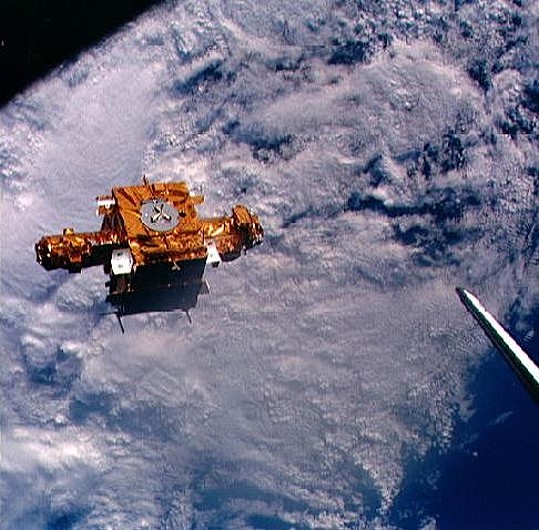
A spectacular launch kicked off a spectacular nine days in orbit for STS-56, during which the crew operated the ATLAS-2 instruments around the clock—with Red Team crewmen Cockrell and Foale monitoring the systems during their 12-hour shift and Blue Team counterparts Cameron, Oswald and Ochoa doing likewise for their 12 hours on duty—and successfully deployed and retrieved the Spartan solar physics satellite. The box-shaped Spartan, which now resides on display at the National Air & Space Museum in Washington, D.C., spent two days in free flight, dedicating a pair of instruments to observations of the Sun’s corona.
All told, STS-56 gathered atmospheric data over 94 percent of the Home Planet, including detailed stratospheric measurements of the Arctic region. Unsatisfactory weather conditions at KSC on 16 April forced the crew to spend an additional 24 hours in orbit, but the 17th proved charmed and Discovery swept into Florida and alighted on Runway 33 at the Shuttle Landing Facility (SLF) at 5:37 p.m. EDT. Aside from their scientific duties, the astronauts also spoke via amateur radio to cosmonauts Gennadi Manakov and Aleksandr Poleshchuk aboard Russia’s Mir space station. It was not the only time that the STS-56 crew would have direct interaction with the Russians. In fact, with the exception of Oswald, all of them would go on to fly aboard Mir or the International Space Station (ISS), later in their careers.
FOLLOW AmericaSpace on Facebook!




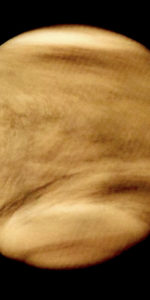
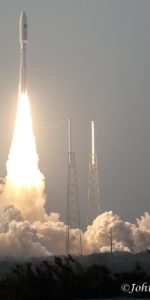
Great article and wonderful memories but I need to point out a couple of corrections. We launched at 1:29a EDT on April 8, and I was on the flight deck for launch. (Mike Foale was on the middeck; we swapped seats for landing 9 days later.)